

World War I. World War I (WWI or WW1), also known as the First World War, or the Great War, was a global war centred in Europe that began on 28 July 1914 and lasted until 11 November 1918.
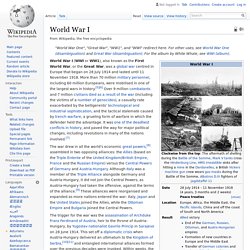
More than 70 million military personnel, including 60 million Europeans, were mobilised in one of the largest wars in history. World War II. World War II (WWII or WW2), also known as the Second World War, was a global war that lasted from 1939 to 1945, though related conflicts began earlier.
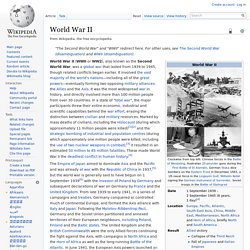
Mutual assured destruction. Aftermath of the atomic bomb explosion over Hiroshima, August 6, 1945 Mutual assured destruction, or mutually assured destruction (MAD), is a doctrine of military strategy and national security policy in which a full-scale use of high-yield weapons of mass destruction by two opposing sides would cause the complete annihilation of both the attacker and the defender.[1] It is based on the theory of deterrence where the threat of using strong weapons against the enemy prevents the enemy's use of those same weapons.
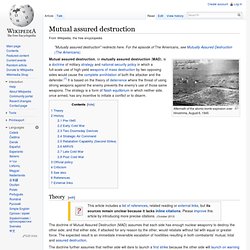
The strategy is a form of Nash equilibrium in which neither side, once armed, has any incentive to initiate a conflict or to disarm. Theory[edit] The doctrine of Mutual Assured Destruction (MAD) assumes that each side has enough nuclear weaponry to destroy the other side; and that either side, if attacked for any reason by the other, would retaliate without fail with equal or greater force. This MAD scenario is often referred to as nuclear deterrence.
History[edit] Pre-1945[edit] Cuban missile crisis. The Cuban missile crisis — known as the October Crisis or The Missile Scare (Spanish: Crisis de octubre) in Cuba and the Caribbean Crisis (Russian: Карибский кризис, tr.
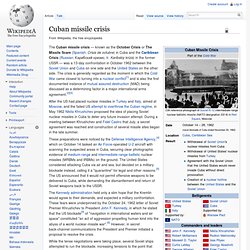
Karibskiy krizis) in the former USSR — was a 13-day confrontation in October 1962 between the Soviet Union and Cuba on one side and the United States on the other side. The crisis is generally regarded as the moment in which the Cold War came closest to turning into a nuclear conflict[1] and is also the first documented instance of mutual assured destruction (MAD) being discussed as a determining factor in a major international arms agreement.[2][3] After the US had placed nuclear missiles in Turkey and Italy, aimed at Moscow, and the failed US attempt to overthrow the Cuban regime, in May 1962 Nikita Khrushchev proposed the idea of placing Soviet nuclear missiles in Cuba to deter any future invasion attempt.
Cold War. Photograph of the Berlin Wall taken from the West side.

The Wall was built in 1961 to prevent East Germans from fleeing Communism and to stop an economically disastrous drain of workers. It was an iconic symbol of the Cold War and its fall in 1989 marked the approaching end of the War. The Cold War was a sustained state of political and military tension between powers in the Western Bloc (the United States with NATO and others) and powers in the Eastern Bloc (the Soviet Union and its allies in Warsaw Pact). Historians have not fully agreed on the dates, but 1947–1991 is common.
It was "cold" because there was no large-scale fighting directly between the two sides, although there were major regional wars in Korea and Vietnam. The two superpowers never engaged directly in full-scale armed combat but they each armed heavily in preparation of an all-out nuclear World War III. Japanese American internment. Japanese American internment was the World War II internment in "War Relocation Camps" of over 110,000 people of Japanese heritage who lived on the Pacific coast of the United States.
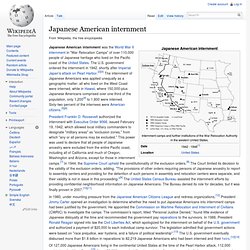
The U.S. government ordered the internment in 1942, shortly after Imperial Japan's attack on Pearl Harbor.[2][3] The internment of Japanese Americans was applied unequally as a geographic matter: all who lived on the West Coast were interned, while in Hawaii, where 150,000-plus Japanese Americans comprised over one-third of the population, only 1,200[4] to 1,800 were interned. Sixty-two percent of the internees were American citizens.[5][6] President Franklin D. Roosevelt authorized the internment with Executive Order 9066, issued February 19, 1942, which allowed local military commanders to designate "military areas" as "exclusion zones," from which "any or all persons may be excluded.
" After Pearl Harbor[edit] San Francisco Examiner, February 1942. Executive Order 9066 and related actions[edit]